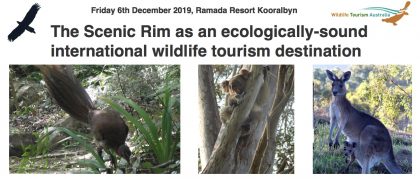Report on Workshop Friday 6th December 2019,
Ramada Resort, Kooralbyn
On this page:
- Some background to the event
- Report on the field trip,
- Report on presentations and discussions
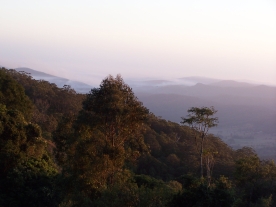
Tourism will grow here in coming decades, but must be well-planned. We have great wines, accommodation and activities, but so do many other places. Not all have the mountains, forests, birdlife, wild kangaroos etc. so close to international airports. Wildlife tourism doesn’t displace other kinds of tourism such as wine-tasting, farm-stays or general sight-seeing, but it can substantially add to it, and if it coaxes a tourist to stay another day or two the local economy will benefit, and the tourist will leave with a more rounded understanding of the region. Visitors to Brisbane, the Gold Coast and the Byron Bay area can also make a detour to include this wonderful region in their itineraries.

Kangaroos, koalas, platypus, kookaburras, cockatoos and colourful parrots and are amongst the most famous of our wildlife, no matter how commonplace they may seem to local residents. Echidnas, lyrebirds (world’s best mimic, and only in Australia), bowerbirds (astonishing architects, and only in Australia and New Guinea), wedge-tailed eagles (Australia’s largest eagle), Paradise rifle bird (the only bird of paradise outside of the tropics), carpet pythons (one of Australia’s largest snakes), goannas (our local land monitor is one of Australia’s largest lizards), glow worms (only in Australia and New Zealand – although young fireflies are sometimes called glow worms in the northern hemisphere) …. this is truly a part of the continent well-set to attract even more international nature-lovers than it does already.
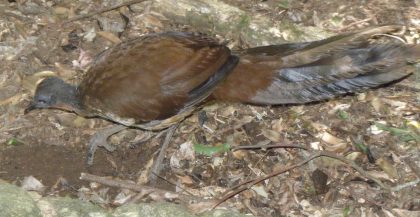
Add to this wonderful mountain scenery, many kilometres of great walking tracks through rainforest and other forests, two international airlines nearby, several well-established tour companies for walking, birdwatching, general wildlife-viewing and general sightseeing tours that include wildlife, and potential for more, two major population centres nearby (Brisbane and Gold Coast), many excellent restaurants, campgrounds and accommodation of all levels within the Scenic Rim itself, and many opportunities to taste local foods, and the potential for much of the local Aboriginal culture to be better known, as well as the neighbouring beaches, whale-watching and theme parks of the Gold Coast for day-trips …
Is it surprising that many international tourists ask us why the Scenic Rim is not better known overseas?
Click here for more information about the Scenic Rim
FIELD TRIP TO SPICERS HIDDEN VALE 5th December 2019
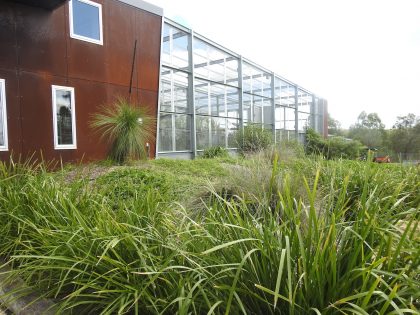
Despite the heat, several of us headed to Spicers Hidden Vale for the workshop. field trip, and were greeted there by Dr Andrew Tribe who leads the conservation breeding programs.
The facilities are mainly for breeding endangered animals of the region for subsequent release on the Spicers property and neighbouring properties where landowners are supportive, but are currently also being used for breeding fat-tailed dunnarts of the outback and mahogany gliders of Far North Queensland. Eastern bristlebirds (whose former range includes the locality) are also being housed and bred.
The laboratories, nesting boxes and wildlife hospital (for the animals at Spicers, not a public facility) are kept at a pleasant 24 degrees Celsius throughout the year – a cool relief in summer and nice and warm in winter when walking in from outside. There are some engaging interactive interpretive devices as well as informative charts.



The laboratories, nesting boxes and wildlife hospital (for the animals at Spicers, not a public facility) are kept at a pleasant 24 degrees Celsius throughout the year – a cool relief in summer and nice and warm in winter when walking in from outside. There are some engaging interactive interpretive devices as well as informative charts.
The aviaries are large, complex and divisible into smaller units as needed, facilitating research.
Anrew then joined us in the Araucaria Ecotours tour vehicle and directed us to one of the areas where they are tracking koalas.
Every breath drew in hot eucalypt-drenched air, and we were grateful Andrew had decided to take us to the location with the least walking needed. We found four koalas within a short time including two youngsters. Andrew explained that this area is to be a “koala fountain”, slowly spraying out koalas in all directions as they breed and their offspring seek new territories. This is already happening. He also told us they are running koala safaris for guests at Spicers (although this wasn’t originally part of the plan) and profits go to the koala conservation project
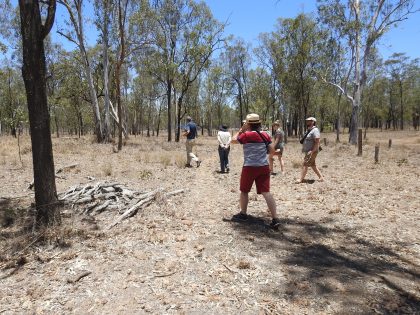
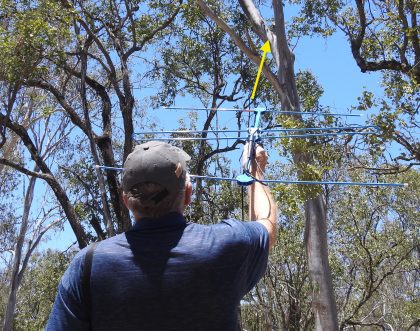


THE WORKSHOP 6th December 2019
Wildlife of Ramada
Jeremy Ring (one of Ramada’s managers, and a wildlife enthusiast), was to have given a talk on Wildlife of Ramada Resort Kooralbyn and future potential, but instead had to fly to Sydney that morning. Ronda gave an overview of the wildlife on the property and the ease of finding it, especially eastern grey kangaroos, whiptail wallabies and various birds. There are also koalas, possums, bearded dragons and other species there, there is a koala trail with named food trees, and Jeremy is supporting a wildlife corridors project by the Scenic Rim branch of the Wildlife Preservation Society of Queensland.
Scenic Rim Regional Counci
Nadia O’Carroll (Councillor) spoke on behalf of the Scenic Rim Regional Council) on the benefits of wildlife tourism adding to the mix of tourism attractions of the region, and also the problems of over tourism already seen in some localities.
Geotourism in the Scenic Rim
Angus Robinson of the Australian Geoscience Council was unable to attend in person, but delivered his presentation via Skype and a powerpoint previously sent to Darren, on “Geotourism in the Scenic Rim and the National Geotourism Strategy.” Geotourism involves geology, biodiversity and cultural aspects of a region. The underlying geology can be fascinating in itself, and explains a lot about why the biodiversity is so high in this region. The Australian Geoscience Council can provide advice on developing geotourism. Angus’s presentation can be viewed by clicking here.
Wildlife of the Scenic Rim
Ronda Green then presented on the diversity of wildlife of the Scenic Rim and the potential for wildlife tourism because of both the biodiversity and the tourism opportunities already here, including the proximity of two international airports. You can download a pdf of this presentation (4.7mb) here:
An Ethical Wildlife Tourism Destination
Robin Rowland (Glow Worm Cave, Cedar Creek Estate, Tamborine Mountain) The Scenic Rim and it’s Potential Role as an Ethical Wildlife Tourism Destination. Robin Rowland (Glow Worm Cave, Cedar Creek Estate, Tamborine Mountain)
Koala tracking and conservation breeding
Our keynote speaker, Dr Andrew Tribe, gave us further details on koala tracking and conservation breeding of endangered species at Hidden Vale. Ecotourism was not part of the original plan. “It sort of crept up on us” Andrew told us, because holiday guests at the accommodation showed a lot of interest. They now run koala safaris, with proceeds fed into the koala project. One very positive result off the safaris is that guests start asking questions and the topics broaden into wider discussions of wildlife and conservation. He also told us that although they are breeding the endangered eastern bristle bird Queensland regulations prevent them from showing endangered animals used for conservation breeding to visitors. This seems unfortunate in that it reduces the incentives for zoos and wildlife parks to get involved in such projects (This does not mean zoos are interested in money for its own sake: payments from visitors help to feed the animals and pay staff to take care of them). The presentation was memory-hungry, so divided into several pdf’s below:
Bat tourism in the Scenic Rim
Maree Kerr and Sera Steves (both members of the WTA committee) presented from afar via Skype on Bat tourism in the Scenic Rim.
Speed Talks
A session of SPEED TALKS on existing wildlife tourism experiences followed:
1.Country Charm Self-drive Tours (Angus Robinson, via Skype)
Over the past decade, Leisure Solutions®has operated an eco-certified, self-drive, packaged ecotour (three or four days duration) in the Scenic Rim https://www.leisuresolutions.com.au/country_charm_scenic_rim/ It was originally developed as a result of extensive consultations with a number of product operators. The tour has been extensively marketed through the internet and has a relatively high profile listing on Google.
Whilst the concept of packaged self-drive tours is relatively new in Australia, a number of factors are at play that my opinion have contributed to its performance as a viable tourism product. These are
Over the past decade, Leisure Solutions®has operated an eco-certified, self-drive, packaged ecotour (three or four days duration) in the Scenic Rimhttps://www.leisuresolutions.com.au/country_charm_scenic_rim/ It was originally developed as a result of extensive consultations with a number of product operators. The tour has been extensively marketed through the internet and has a relatively high profile listing on Google.
Whilst the concept of packaged self-drive tours is relatively new in Australia, a number of factors are at play that my opinion have contributed to its performance as a viable tourism product. These are
- Branding of the Scenic Rim is very confusing and conflicts with the better know branding of the ‘Gold Coast Hinterland’.
- In marketing a package, reliability of component products is critical; the Scenic Rim is characterised by the lack of long-term commitment by small businesses.
- Packaging of reliable quality catering facilities is difficult particulalry in some places eg Boonah where restaurants close on a Monday. Locating a suitable quality café for lunch has always been a challenge.
- Apart from resorts such as Binna Burra (now destroyed by recent bushfires), O’Reillys, Mt Barney and Spicers, quality (minimum 4 star standard) accommodation is hard to find. O’Reillys’ does suffer from the disadvantage that road access to the Resort is very difficult and not recommended for inexperienced drivers. However, the announcement that a $40 million upgrade to the Lamington National Park road has recently been completed may well have addressed this perception.
- Quality reliable indigenous cultural product is not available at present.
- In periods of heavy rainfall (past years), some sections of the road traversed by the tour are unusable owing to landslides.
- In comparison to other regions in Australia, the Scenic Rim can only be described as a ‘developing’ tourism region, particulalry in regard to overseas tourist interest.
2.Binna Burra (Barry Davies)
Barry (who was activities manager at Binna Burra for many years)spoke of his long association with Binna Burra, the shock of its sudden destruction in the catastrophic fire in September 2019 and plans to re-build. All involved are determined that whatever building materials are used in the new version, it must reflect the same character of the original. The campground, Groom’s cottage and some of the upmarket sky-lodges were spared, and will be open in the first half of 2020, when the badly-damaged roads are fully repaired. Most of the lodge is now ash, but the old dinner bell was found – good news for visitors who remember years of being called to breakfast or dinner by that bell – and Barry. is now officially the “Keeper of the Bell” until Binna Burra is rebuilt.
3.Gondwana Guides (Barry Davies)
Barry then spoke of the bird-watching tours led by his own company Gondwana Guides, which until recently often visited Binna Burra. The tours still head to O’Reilly’s Rainforest Retreat and other parts of the Scenic Rim, as well as further afield in Far North Queensland, Northern Territory, New Zealand and occasional Papua New Guinea. Although the major focus is birds, other aspects of natural history are often included, and tours are generally customised to the interests off his guests.
4.Cedar Creek Glow Worms (Robin Rowland)
Robin spoke of the very well-designed and convincing artificial cave at Cedar Creek Estate on Tamborine Mountain, which a few hundred glow worms were released into some years ago and now there are thousands, looking like pale green stars as guests are safely guided through the darkness of the second chamber. The first chamber is light at first, and guests can admire the very realistic stalactites and stalagmites near the very clear stream running through the cave, then darkens as they watch a film on the life-history of the glow worms. The cave gives tourists a chance to see glow worms during the day, because lights turn on and off to reverse the night/day cycle, and it also both takes the pressure of wild colonies in the forest and gives a chance to tell many people how to behave when watching wild glow worms. Frog Hollow is on the same property (which is essentially a vineyard, restaurant and function centre), giving visitors a chance to see a number of local frog species.
5.Araucaria Ecotours (Ronda Green)
Ronda Green (chair of Wildlife Tourism Association) started Araucaria Ecotours over 20 years ago, with a focus on visitors learning about wildlife ecology and behaviour and why Australia is so different from other world regions. Guests on the longest-running tour (three-day wildlife tour, which brings people from Brisbane to the Scenic Rim as well as a couple of neighbouring shires) receive a purpose-written book on Australia’s major wildlife groups. Day tours including the Scenic Rim include a birdwatching tour and a wildlife tour, plus various custom tours.They are also developing a wildlife ecology centre and associated nature trails (currently under renovation) at their forested property to the west of Lamington National Park, and intend including more citizen science activities in future tours.
6.Mt Barney Lodge (Innes Larkin)
Tracey and Innes were also away, but prepared a short video which unfortunately reached us after the close of the workshop. They have recently been urging businesses and Council to declare a climate emergency, and present that here also. The video can be viewed here
Indigenous perspectives
Indigenous perspectives on wildlife tourism were presented by John Long, an Ugurapul elder who has lived all his life in the region, in semi-traditional style for most of his childhood because of an understanding his father had with a land-owner who allowed the extended family to live on his land, tell stories around the campfire, hunt and collect traditional food etc. and has a tremendous knowledge of his culture and the wildlife and forests that were here in his youth. He said he greatly appreciated the opportunity to talk, and gave us examples from over the decades when decisions were made by developers and politicians, or sometimes even with utter disrespect such as deliberately urinating on a tree after having just been told why it was so sacred to them, and the destruction of much cultural heritage. He made a plea for his people, who have lived here for millennia, to be treated with respect, to be consulted properly and have meaningful discussions when changes are to be made to elements of the landscape that hold deep meaning for them. He also said he was never interested in playing didgeridoo or dancing for audiences. That wasn’t really introducing people to his culture, and he does want to introduce others to it, but by encouraging walking and talking together, again with true respect, and surrounded by the natural landscapes and fauna and flora. (I remember his brother Frank telling me many years ago that the only way to hear traditional stories is sitting around a campfire). The fauna and flora have changed over the decades – the rivers of fire – the brilliantly blooming red bottlebrushes along our creeks – no longer put on such a magnificent show maybe because nowadays they lack their best pollinators or some other factor of their environment. The grasshoppers no longer swarm, and sand goannas are nowhere to be found. He would like to see more of the land returned to forest (and in fact I first met him when he visited our property earlier this year to help plant some wildlife-friendly plants on tree-planting day).
Summary:
- Many natural and cultural features have been lost
- The First Nations people should be included in any plans to alter natural or cultural heritage sites, and be treated with respect
The Scenic Rim Trail.
Kira Klein, of Spicers Hidden Vale then gave us details of The Scenic Rim Trail.
This Trail is within the Scenic Rim as defined geographically, but not within the Scenic Rim Regional Council area (being instead in the Lockyer Valley Regional Council). Spicers own several nature reserves in this region and the Southern Downs Region. The Spicers Peak Nature Refuge (with 7 km adjoining the boundary of the Main Range NP) was declared in 2006, protected in perpetuity through a Conservation Agreement between
the owner (and all future owners) and the Queensland Government, and covers 2000 hectares. The Thornton View Nature Refuge was declared in 2006 and is 320 hectares. The Old Hidden Vale Station Nature Refuge (which doesn’t adjoin the Main Range National Park) is 3091 hectares and was declared in 2007 along with the Old Hidden Vale Koala Habitat that was declared in 2012. Total of all the nature refuges is 5411 hectares or 13,370 acres.
The accommodation for hikers on the three-day walk are within the national park, and accordingly subject to many strict regulations. The accommodation itself is designed to be eco, the toilets that are to be established for instance using only half a cup of water per flush. Although use of the accommodation is limited to 40 per week, the Trail itself (also within the Main Range NP) is open to the public at all times, with no charge.
Wildlife of the area includes eastern grey kangaroo, whiptail wallaby, red-necked wallaby, brush-tailed rock-wallaby, koala, bandicoots, phascogale, spotted-tailed quoll, echidna, glossy black cockatoo, powerful owl, sooty owl, Albert’s lyrebird, regent honeyeater, eastern bristlebird, and many other species as well as threatened plant species and a variety of ecosystems. Kangaroos, wallabies and many birds are very ease to find – some of the others may take a little more patience and luck. Staying overnight gives an opportunity to hear and see nocturnal creatures.
[Chair’s note: The trail includes private land and a small section of a national park. Although many, including WTA, generally oppose the inclusion of facilities within a national park, this one already legally exists (one of only two in Queensland) after a very lengthy process including research and stringent conditions, and the owners have demonstrated their commitment to conservation, so we are happy to now promote this trail to domestic and international travellers. See https://parks.des.qld.gov.au/tourism/ecotourism/main-range/ We continue to urge that future facilities be constructed on private or leasehold land, with very occasional possible exceptions such as the already-cleared woolshed area within the enormous Currawinya National Park, and also encourage activities such as birdwatching and other wildlife viewing as well as horse-riding, mountain biking etc. on freehold and leasehold properties to take the pressure off national parks, which are increasingly needed for biodiversity conservation . We do not condone anything that goes against the conservation ideals the parks were set up for, or detracts from wilderness experience. There is a difference however between protesting against future inappropriate use of national parks and supporting a facility which already exists and has been achieved legally and with strict environmental conditions agreed to]
The Scenic Rim as an eco-certified destination
Rod Hillman (CEO, Ecotourism Australia) presented a recommendation of The Scenic Rim as an eco-certified destination.
Rod showed us a video of the world’s first destination to achieve eco-certification through Ecotourism Australia, Douglas Shire in FNQ. We don’t have a link to the video, but here is a link to information on how Ecotours Australia, the Douglas Shire Council, and local operators worked to achieve this. https://www.ecotourism.org.au/news/media-release-douglas-shire-becomes-worlds-first-eco-certified-destination/
The Challenge
How do I :
- Make my Region stand out from the crowd? Highlight our natural and cultural assets?
- Engage my community as a key feature of my tourism product?
- Improve the sustainability of my region?
- Give my tourism marketing credibility and authenticity?
What research is telling us
- Visitors, and the community generally, have low levels of trust.
- Visitors want authenticity, they want genuine experiences.
- Visitors want things to be different – but better than home.
- Visitors are increasingly choosing destinations, tours and accommodation based on their sustainability credentials.
What others are doing
- A global trend is for regions – tourism destinations– to seek independent and verified certification.
- There are now close to 300 certified or awarded tourism destinations globally.
- Using programs to assess and gain a social license for their activities
- Changing their perceptions from ‘ Visitors’ to ‘ Guests’
What about Australia
- Regions are rediscovering ‘Product Development’ and that just promotion is not enough.
- The rise of ‘Hero Experiences’ that define a region.
- Tourism Australia’s ‘Great ……..’ collections’
- Strong Government investment in regionally based tourism products within National Parks
- The beginnings of independently branded and verified destinations
- Douglas Shire, Lord Howe Island, Townsville & Mt Hotham are good examples
ECO Destination Certification
- An online, but coached, program to assess your region’s ecotourism and sustainable tourism policies and practices against a globally recognized standard.
- A way to receive official recognition for best environmental and professional practices.
- A tool to reassure visitors that your marketing promise is authentic and genuine.
- A method to engage your residential and business community
Why ECO
- Ecotourists stay longer, spend more and are genuinely interested in your community, nature and culture.
- Ecotourists value and appreciate a region’s sustainability efforts.
ECO vs Sustainable
- All ecotourism is sustainable BUT not all sustainable tourism is ECO.
- ECO Destination Certification is based on 100 sustainability criteria PLUS ecotourism criteria.
- An ECO Destination must have ecotourism product and well managed protected areas
Is it right for me?
Do you have
- Natural (and cultural) assets and areas that are protected and cared for?
- Established engagement strategies to work with your residents and business communities?
- High quality ecotourism product – tours, attractions and accommodation?
- A willingness to create a business environment that rewards ecotourism businesses?
Rod Hillman, ceo@ecotourism.org.au
Chair’s note: the Scenic Rim has some important national parks, including Lamington National Park, which together with the adjoining Border Ranges National Park, harbours the largest expanse of subtropical rainforest in the world and an excellent series of walking tracks it would be economically near-impossible to replicate nowadays. The Protected Areas, including other national parks and council-owned land, harbour a great diversity of species and habitats, including a number of rare and threatened ones. Several tourism operations in the area are both eco-certified by Ecotourism Australia and members of Wildlife Tourism Australia (Gondwana Guides, Mt Barney Lodge, Cedar Creek Glow Worms, Binna Burra, O’Reilly’s Rainforest Retreat, Country Charm, Araucaria Ecotours). The wildlife conservation activities at Spicers Hidden Vale (Andrew Tribe is a WTA member) are outside the Council area but the rehabilitated animals don’t respect political boundaries and will probably spread across. Council has been supportive (financially and otherwise) of several wildlife conservation initiatives of the Scenic Rim branch of Wildlife Queensland. There is a range of accomodation on offer, including two of Australia’s longest-running eco-lodges, O’Reilly’s and Binna Burra (which will rise again, despite the recent disaster) The WTA committee voted after the workshop to recommend the Scenic Rim apply to become an Eco-Destination.
Ecological sustainability
Ronda Green
Sustainability can mean:

- Environmental/Ecological sustainability – protecting the wildlife and the landscapes tourists wan to see (which also assists economic sustainability), and protecting biodiversity in general (a social responsibility), including all the species sharing the ecosystems but not noticed by tourists or even tour operators.
- Economic sustainability – protecting what tourists want to see (as above), ability of the locality and the individual businesses (good service, facilities, useful business plans etc.) to continue to attract paling customers, flow-on effects (if tour businesses are doing well, so do service stations, cafes and other local businesses), ability of businesses to donate some of heir profits towards environmental sustainability
Often the two are in harmony, but there are sometimes conflicts:
| Activity | Why do it? | Problems | Compromise |
| Feeding wildlife | Animals can be reliably shown to tourists. Animals come close for photos. Interactions provide positive feelings. Education about the annual can be enhanced by close encounter | Population increase and behavioural changes of animals can affect the and other species. Disease can spread in feeding areas. Some animals become aggressive towards other humans not feeding them. Wrong foods can be offered. | Allow feeding in restricted areas (not in wilderness), with proper education on how and what to feed and ideally under supervision. Keep up to date with research-based advice. |
| Bird calls | Playing a bird’s territorial call can bring one closer for observation and photography | Territorial birds can use up much-needed energy evening against “intruders” with less to spare for feeding themselves and their young, and may give up and move to sub-optical habitats. | Allow low-level use in some areas, ban from others, especially in breeding season. |
| Captivity | Most reliable way of viewing some animals. Good for tourists on a short visit. Can provide a “back-up” of a species that is now threatened and with little native habitat left. | Animals can suffer fear, boredom, loneliness, hunger and discomfort if not adequately housed. Captive animals are not contributing their genes to will populations.Some tourists object of the whole idea of captivity. Fear by some conservationists that having threatened species in captivity will lessen efforts to protect wild habitats. | Design enclosures , feeding regimes etc. to give the animals not only lack of suffering but a life to positively enjoy. Ensure any captive facility is genuinely providing conservation (e.g. captive breeding of endangered species and science-based relate of progeny to the wild, habitat restoration in regions of the species’ natural distribution.), good education to the public (tourist and local) and relevant research |
| Access | Tourists short on time or not very fit want access to all interesting places. Businesses can make more revenue with more tourists | Roads to every hilltop would result in trampling of rare plants etc. and also deprive wilderness-seekers of a feeling of accomplishment. Additional roads and wide tracks through forests, an off-road 4WD, can disturb animals, especially when breeding, an bring in fungi and weed seeds. “Overtourism” can detract from wilderness experiences and general enjoyment by visitors. | Provide easy access to a few major locations that are scenic or rich in wildlife and leave others only for hogs willing and able to make an extra effort, plus some very vulnerable areas with no access at all except for selected researchers and conservation workers. |
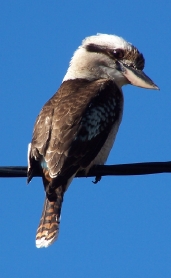
General Discussion:
How do we keep an increase in tourism ecologically sustainable? What kinds of tourists do we most wish to attract? How do we market effectively to the “right” kinds of tourists?
The Scenic Rim is an ideal destination for wildlife tourism (see below for a summary) but apart from a couple of well-known operations does not get anywhere near the publicity either nationally or internationally as some other destinations enjoy. We want to tell the world about it but in a way that attracts the “right” kinds of tourists, those who desire a connection with nature, keen to learn about and to quietly view our wildlife with minimal disturbance. We don’t want a sudden expansion of mass tourism destroying the atmosphere and the very things that make our region such a magic place. This takes planning and communication between all stakeholders.
There’re some similarities between operations in what kinds of tourists would be moist welcome. Respect for the wildlife and local residents (also for fellow travellers and guides) is a big one – not the kind of tourist who will do anything for a selfie or other photo regardless of how it affects others, or insists on trespassing on private property to get closer to birds or kangaroos. There are also differences. Some will want to attract adventurers, others may be more likely to target families or seniors. A genuine interest in wildlife and willingness to spend a bit of time looking and learning would be welcomed by some, but there is also a good opportunity with short tours (e.g. the guided glow worm tours) that guide large numbers of people on a daily basis, to capture the interest of those who just included a wildlife experience as an add-on to more general touring, and to get them thinking about insect ecology and behaviour and minimal-impact viewing.
How to attract the right tourists can be challenging. Targeted advertising can reach people with particular interests. Photos that appeal to people interested in wilderness and wildlife are a must, but must be accurate (not showing interactions that are discouraged, or people in places they are not allowed for safety reasons)
Some parts of the Scenic Rim (e.g. Cedar Creek Falls) are already subject to over-tourism, and there are decisions to be made as to whether to just consider these as “sacrifice sites” or to reduce numbers by entry fees or active management of numbers allowed to enter. An example was also given of Dove Lake in Tasmania, where visitors can no longer drive their vehicles all the way to the lake, but must park and ride a National Park bus for the last few kilometres.
Although birdwatching is a favourite pastime and recorded calls are often used to lure birds, it may be necessary to ban or severely restrict the calls in areas of over-use, especially in breeding season when bird need to spend their energies feeding their young without wasting energy on defending their territories from imagined intruders.
A follow-up workshop will probably be held in 2020 to discuss marketing and management in more detail..
A few more notes about the Scenic Rim and the Workshop

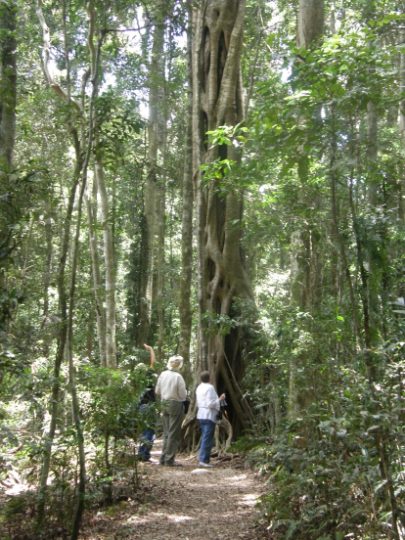
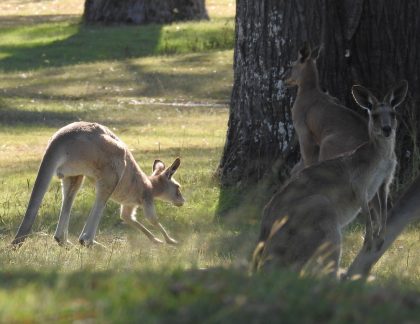
Why the Scenic Rim?
(further details from our original promotion of the workshop)
The Scenic Rim has numerous features well-suited to tourism in general:
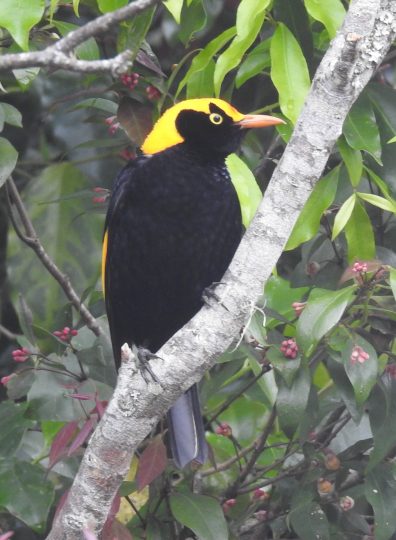
- It is less than a 90-minute drive from two international airports (Brisbane and Gold Coast)
- It is close to other major tourism destinations (just inland from the Gold Coast, and a 90-minute drive north from Byron Bay), making it convenient for a multi-day tour or drive encompassing all of these, or day-trips from one to the other.
- The weather is generally good throughout the year, the winters and summers tending to be milder than many other regions (and the forested mountains provide relief from the summer heat of low-lying regions)
- It not only harbours the largest rainforest outside of the tropics anywhere in the world but one of the world’s best systems of safe rainforest walking tracks (no large predators or guerrilla fighters, and you can easily walk for a couple of weeks without doing the same walk twice), as well as many other scenic walks through open forests
- There is already plenty of infrastructure, including two of Australia’s earliest eco-lodges (established before the word “ecotourism” was coined), many other styles of accommodation and camping options to suit couples, families, groups and singles, two canopy walks, glow worms that can be visited in daylight hours, etc.
- There are already plenty of activities on offer: long-running events such as bird weeks and photography weeks, established tours to conduct overnight hikes, birdwatching and other wildlife treks, horse-riding, canoeing, hot-air ballooning etc.
- There are many extras that tourists can enjoy in-between wildlife-watching: wine-tasting, fine dining, arts & crafts, great scenery …

The Scenic Rim has over 40 species of frog
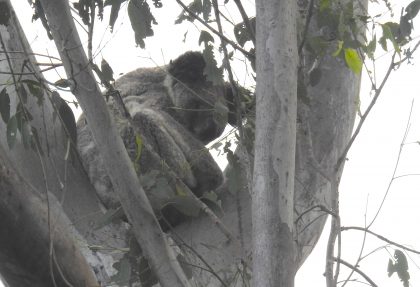
- Most of the famous Aussie icons exist here: kangaroos, koalas, platypus, echidna, dingo, kookaburra, wedge-tailed eagle, lyrebird, bowerbirds, cockatoos, parrots, goannas, bearded dragons, carpet pythons, green tree-frogs, and colonies of glow worms
- There are many less well-known but beautiful, bizarre and fascinating species. It harbours for instance the Richmond birdwing (Australia’s second-largest butterfly), the only bird of paradise outside of the tropics, a large blue freshwater crayfish, leaf-tailed geckos, thousands of large fruitbats swirling into the sky at dusk, many species of fauna and flora found nowhere else, and critically-endangered species such as bristle birds and fig-parrots (visitors are unlikely to see the critically-endangered ones, but can view their habitats and learn about their plight).
- It forms part of the third-highest biodiversity region in Australia, partly due to the Macleay-MacPherson overlap, where subtropical and temperate conditions exist side-by-side and many northern species reach their southern limits and southern species reach their northern limits. The rich soils and complex landscapes from three major ancient volcanoes and the high rainfall from winds blowing in from the Pacific Ocean also allow the diversity of habitat and wildlife species
- Being close to the Gold Coast, it is also a short drive to add whale-watching, diving with turtles or seeking shorebirds to the visitor experience.
The Scenic Rim is also very rich in wildlife, including those tourists often want to see plus many they’ve never heard of.
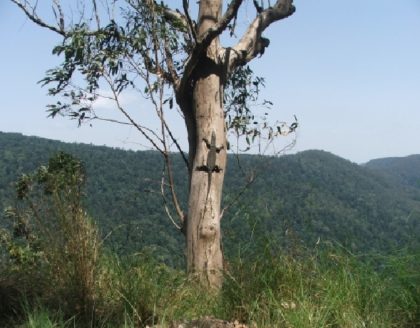
Geographically, the Scenic Rim, formed by three major volcanoes between 25 and 22 million years ago, runs from near Toowoomba (west of Brisbane) down to the NSW border and eastwards through Mt Barney and the Border Ranges of northern NSW and Lamington National Park on the Queensland side, and on through Springbrook almost to the coast. The political definition lies within this, as Scenic Rim Regional Council. We are here using the geographic description.
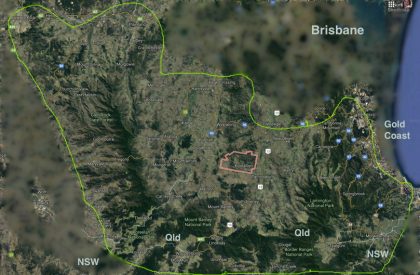
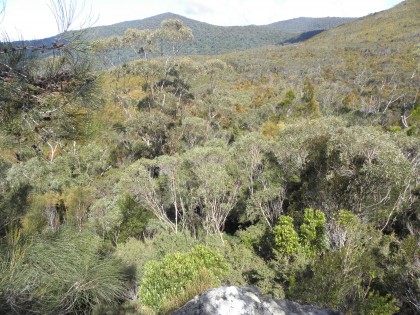
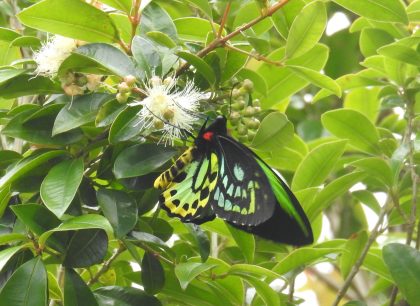
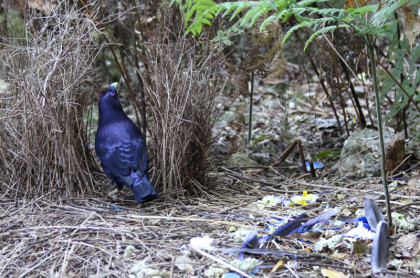
Bowerbirds fascinate international guests, and they can be seen only in Australia and New Guinea. We have two species in the Scenic Rim and there are places we can almost guarantee sightings of the bower of the satin. This one is at O’Reilly’s. Photo Araucaria Ecotours.
Habitats in the Scenic Rim include mountainous terrain with a variety of rainforest, open eucalyptus forest and heaths, and valleys with rivers and creeks, swamps and sheoak-dominated riparian woodland. It includes the largest area of rainforest outside the tropics anywhere in the world, and one of the best and safest systems of walking tracks in rainforest anywhere in the world, as well as two rainforest canopy walks and many scenic waterfalls. Glow worms (found only in Australia and New Zealand)
The Scenic Rim is an easy drive from two international airports (Brisbane and Gold Coast), and has a range of accommodation types and tours. In between birdwatching and other wildlife-viewing, visitors can enjoy the restaurants, markets, art galleries and wineries, and can indulge in activities such as hiking (including multi-day), rock-climbing, hang-gliding, hot air ballooning, horse-riding, helicopter flights, massages in the mountains, swimming, kayaking or just relaxing in the forest or on a verandah admiring the view. They can also visit conservation projects such as the breeding and re-introduction of endangered species to Hidden Vale in the northwest or join a full week of birding or nature photography at ecolodges adjoining Lamington National Park.
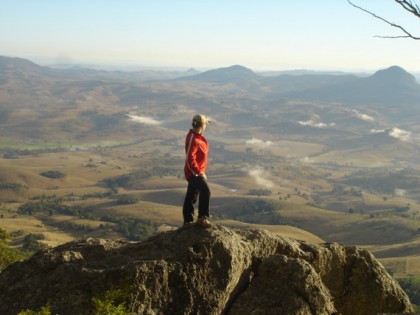

Our keynote speaker: Andrew Tribe
Dr Andrew Tribe has worked with wildlife for the past 35 years, particularly in the areas of management, welfare and rehabilitation. For 24 years he was Senior Lecturer in Wildlife at the University of Queensland and is internationally recognised for his research and teaching in wildlife welfare, behaviour and management.
He has had extensive experience working with captive wildlife and is recognised as an authority on zoos. Dr Tribe was the Senior Veterinarian at Melbourne Zoo from 1985 to 1991, and has recently undertaken research looking at their opportunities, and challenges for the future.
Since 1994, Andrew has also led wildlife tours to Africa. These tours are designed to both observe African wildlife in its natural setting, and to give the tour group an insight into their behaviour, management, and conservation.
From 2016, Andrew has been Wildlife Manager for the Hidden Vale Wildlife Centre near Grandchester in south east Queensland. This facility is being run in conjunction with the University of Queensland to support conservation initiatives through teaching and research.
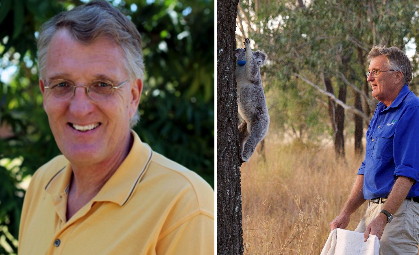
Ramada Resort – conference venue and accommodation
The workshop venue Ramada Resort Kooralbyn has rooms available for the special rate per room (one or two persons) per night of $134 for a room with twin queen beds or $151 for a room with a king bed plus twin sofa bed in the lounge room,.

